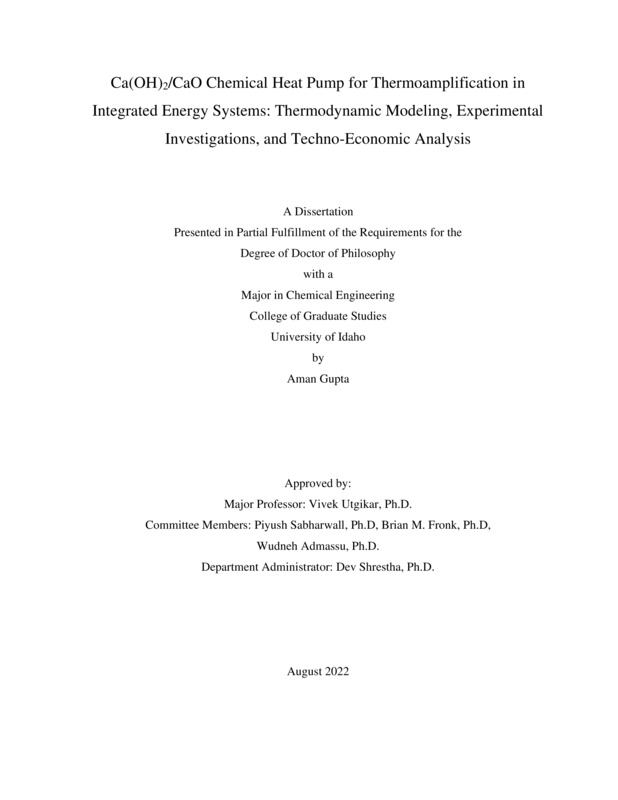Ca(OH)2/CaO Chemical Heat Pump for Thermoamplification in Integrated Energy Systems: Thermodynamic Modeling, Experimental Investigations, and Techno-Economic Analysis
Gupta, Aman. (2022-08). Ca(OH)2/CaO Chemical Heat Pump for Thermoamplification in Integrated Energy Systems: Thermodynamic Modeling, Experimental Investigations, and Techno-Economic Analysis. Theses and Dissertations Collection, University of Idaho Library Digital Collections. https://www.lib.uidaho.edu/digital/etd/items/gupta_idaho_0089e_12435.html
- Title:
- Ca(OH)2/CaO Chemical Heat Pump for Thermoamplification in Integrated Energy Systems: Thermodynamic Modeling, Experimental Investigations, and Techno-Economic Analysis
- Author:
- Gupta, Aman
- ORCID:
- 0000-0003-0284-3856
- Date:
- 2022-08
- Embargo Remove Date:
- 2023-03-02
- Keywords:
- Calcium Hydroxide-Calcium Oxide Chemical Heat Pump Kinetic Analysis Techno-Economic Analysis Thermal Energy Storage Thermodynamic Modeling
- Program:
- Chemical & Biological Engineering
- Subject Category:
- Chemical engineering
- Abstract:
-
The energy economy is continually evolving in response to socio-political factors in the nature of primary energy sources, their conversions to useful forms such as electricity and heat, and their utilization in different sectors. Nuclear energy has a crucial role to play in the evolution of energy economy due to its clean and non-carbon-emitting characteristics. Integrated Energy Systems (IES) are collaboratively controlled systems may dynamically apportion thermal and/or electrical energy to promote the production of various energy products, and have potential to reduce GHG emissions, improve energy efficiency, improve electrical grid dependability, and enhance energy economics. The reversible decomposition reaction of Ca(OH)2 has attracted wide attention and research for thermochemical energy storage system (TCES). Chemical Heat Pump (ChHP) or temperature amplification aspect of the system was not studied in detail in the literature. In this work, thermodynamic modeling, experimental investigation and techno-economic analysis were conducted. A refinement of the equilibrium relationship between pressure and temperature governing the reversible reaction is presented by incorporating temperature dependence of the thermodynamic properties and the effect of non-ideality in the vapor phase. The results showed the temperature dependence of enthalpy influences the equilibrium and the non-ideality in vapor phase can become significant at pressures greater than 2 MPa. The refined relationship predicts higher equilibrium pressures for any temperature than those equilibrium relationships that neglect the temperature dependence of thermodynamic quantities. Thermogravimetric analyzer was used to perform kinetic analysis of pure Ca(OH)2 decomposition at various temperatures, yielding kinetic parameters - activation energy and Arrhenius constant with derived rate control equations for isothermal and non-isothermal conditions. CaTiO3 is added to Ca(OH)2 at different compositions to enhance kinetic parameters in form of composite pellets which showed significant increase in activation energy and Arrhenius constant values. Repeated dehydration-hydration cycles were conducted in a bench scale reactor system under various reaction conditions. The experiments were firstly conducted with powdered and pelletized Ca(OH)2 and then with composite pellets comprising inert agent. It was found that the temperature rise during hydration reaction was dependent on the extent of conversion during the dehydration process. Visual and scanning electron microscopic examinations of the product after each reaction revealed structural changes and formation of cracks in the Ca(OH)2 pellets but no cracks were developed after 20 cycles when composite pellets we used. A techno-economic analysis was undertaken to establish the viability of selling heat along with electricity for an advanced 100 MWth small modular reactor (SMR) and four nuclear hybrid energy system (NHES) configurations featuring the SMR paired with chemical heat pump (ChHP) systems providing a thermal output ranging from 1 to 50 MWth. Net present value, payback period, discounted cash flow rate of return and levelized cost of energy were evaluated for these systems for different regions of U.S. reflecting a range of electricity and thermal energy costs. The analysis indicated that selling heat to high temperature industrial processes showed profitable outcomes compared to the sale of only electricity. Higher carbon taxes improved the economic parameters of the NHES alternatives significantly. Providing heat to high temperature industries could be very beneficial, helping to cut down the greenhouse gases emission by reducing the fossil fuel consumption.
- Description:
- doctoral, Ph.D., Chemical & Biological Engineering -- University of Idaho - College of Graduate Studies, 2022-08
- Major Professor:
- Utgikar, Vivek
- Committee:
- Sabharwall, Piyush; Fronk, Brian; Admassu, Wudneh; Shrestha, Dev
- Defense Date:
- 2022-08
- Identifier:
- Gupta_idaho_0089E_12435
- Type:
- Text
- Format Original:
- Format:
- application/pdf
- Rights:
- In Copyright - Educational Use Permitted. For more information, please contact University of Idaho Library Special Collections and Archives Department at libspec@uidaho.edu.
- Standardized Rights:
- http://rightsstatements.org/vocab/InC-EDU/1.0/

